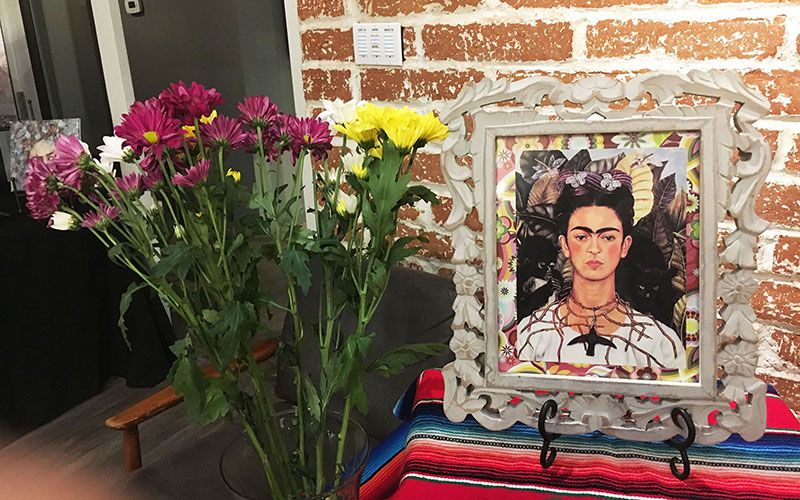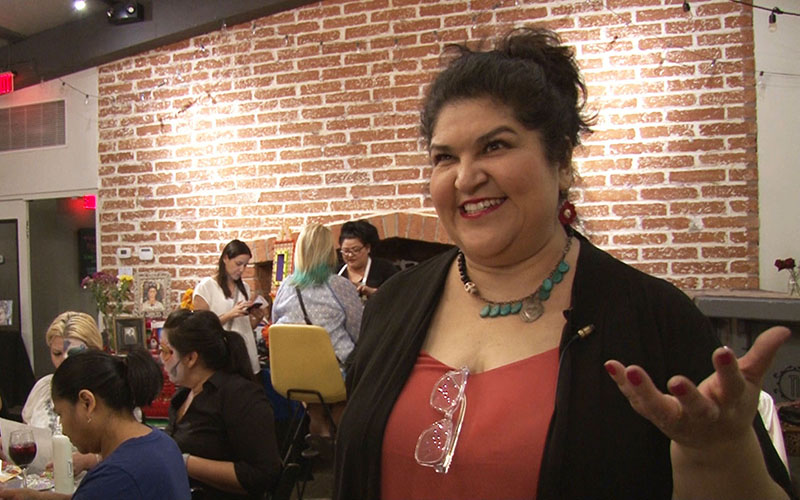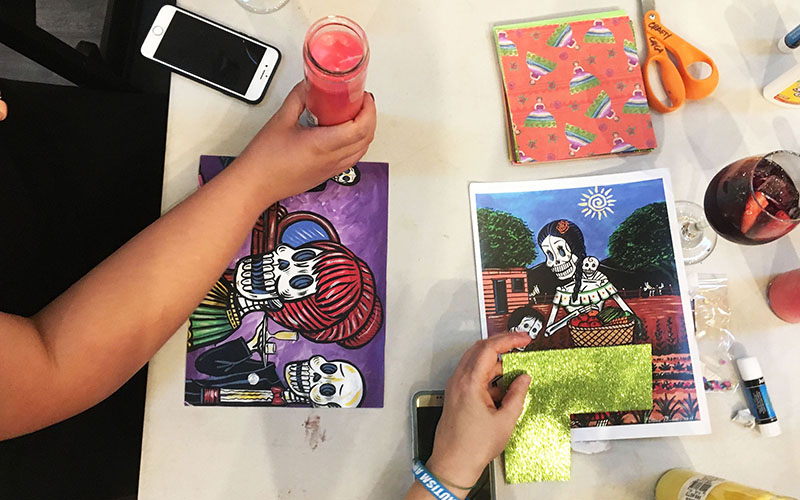
A portrait of Frida Kahlo, the famous Mexican artist the Phoenix Fridas are named after. (Photo by Fortesa Latifi/Cronkite News)

Monique Sanderson-Mata paints Kendall Gumm’s face. (Photo by Fortesa Latifi/Cronkite News)

The details of Kendall Gumm’s face-paint. (Photo by Fortesa Latifi/Cronkite News)

Kathy Cano-Murillo, the founder of the Phoenix Fridas, talks about celebrating Dia De Los Muertos, not mourning for the dead. (Photo by Fortesa Latifi/Cronkite News)

Participants decorate candles with images from the holiday. (Photo by Fortesa Latifi/Cronkite News)
PHOENIX – A woman sat at a table, patiently sewing an orange sugar skull with blue eyes and a pink button nose. She untangled a ball of yarn and worked nimbly, adding a flower bow and a black mouth.
At a different table in the same room, someone cut purple paper and taped it to a six-inch cardboard box to create a mini shrine. The words ‘feed your soul’ were written across it. At the front of the room, a woman blotted a damp sponge into a pot of white face-paint.
The Phoenix Fridas, a Latino art collective, hosted a Dia de los Muertos (Day of the Dead) themed craft night at Changing Hands Bookstore on Wednesday. Kathy Cano-Murillo, the founder of the Phoenix Fridas, said the event was meant to “share education in a fun way” about the Mexican holiday.
“Dia de los Muertos is a 3,000-year-old tradition from Mexico,” Cano-Murillo said. “It’s a celebration of life – a way of embracing and accepting death as part of the journey and not fearing it.”
Cano-Murillo wore bright colors and smiled as she talked about Dia De Los Muertos. If there’s one thing she wanted people to take away from the event, she said it was that the holiday wasn’t only about mourning, but celebrating, too.
Monique Sanderson-Mata agreed. Sanderson-Mata, who is a member of the Phoenix Fridas, painted faces at the event. Her connection to famed artist Frida Kahlo, is more personal than most.
After an accident which broke her spinal column in three places, Kahlo was confined to her bed for two years. As she healed, she painted and developed the style that would be celebrated around the world.
Sanderson-Mata was also in an accident. Her accident left her in a wheelchair for six months. She had to relearn how to walk.
“I know what it’s like to have that struggle, to have to depend on people, to feel helpless,” Sanderson-Mata said. “And art is the only thing that got me through that.”
As Sanderson-Mata painted, she kept up a constant stream of conversation and jokes. She wore a brightly colored art smock over a black t-shirt. She prefers bright colors, choosing purple and blue and red, even though Day of the Dead face painting is often centered around black and white colors. Her favorite part of face-painting is the symbolism.
“You’re identifying with, ‘hey, this is what I might look like being gone and this is what I look like alive,'” she said. “It’s celebrating both sides of life and death.”
Dia de los Muertos is a Mexican holiday celebrated on Nov. 1 and 2. The holiday honors the dead by constructing altars and decorating them with candles, sugar skulls and food among other offerings. Many cities hold parades for Day of the Dead, including Phoenix and Tucson.
The sugar skull is one of the most recognizable icons of Day of the Dead.
“The sugar represents the sweetness of life and the skull represents that their body isn’t here, that they’re gone,” Cano-Murillo said.
The skulls are used on everything from Day of the Dead candles to face painting. Kendall Gumm had her face painted at the event.
“You’re my first face of the season!” Sanderson-Mata said excitedly.
Gumm sat patiently as Sanderson-Mata painted a green circle around her left eye. The green circle was encircled in a bright blue ring. On the edge of the ring, Sanderson-Mata carefully laid tiny plastic crystals.
Afterward, Sanderson-Mata handed her a mirror and Gumm broke into a smile.
“I have a lot of family members I like to honor this way,” Gumm said.
That evening, she chose to honor her grandfather, father and uncle. There’s a reason she takes part in Dia De Los Muertos.
“I like the feeling,” Gumm said. “It’s the happiness – you’re celebrating their life, even in their death.”
Sanderson-Mata chose to honor a family member of her own. She pointed to the shrine at the front of the room, where participants had laid sugar skulls, momentos and pictures of loved ones.
“That’s my little brother,” Sanderson-Mata said, touching the picture lightly. “He died on my wedding day.”
Throughout the event, participants shared stories of their late loved ones, but the atmosphere wasn’t one of mourning. Instead, even as they said the names of the people they were honoring, participants laughed and drank wine and smiled. They decorated candles and sewed sugar skulls. Some laughed at their lack of artistic ability and asked their neighbors for help. Others spent the entire time at one table, perfecting a single craft.
They lived, as they celebrated the lives of those they lost. That, Cano-Murillo said, was the point.
“It’s so easy to fall into that level of sadness in mourning,” she said. “But with Dia De Los Muertos, it’s a way to take control and say, this isn’t about me being sad. This is about me feeling blessed that I had this person in my life, that I had these life lessons to learn from them. And I want to celebrate them on this day.”